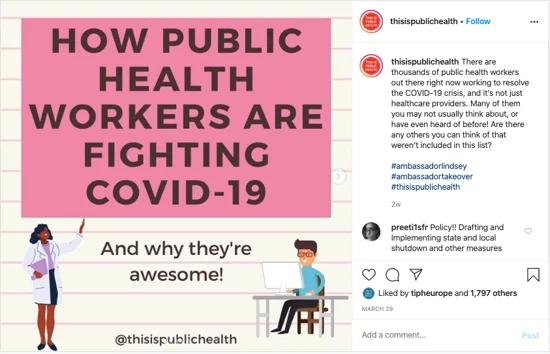The field of public health is absolutely critical to the sustained health and wellness of the general population. Numerous aspects of our daily lives are impacted by public health, such as nutrition, healthcare, community planning, sanitation, lawmaking, and more. Today, more than ever, the efforts of public health professionals are focused on making decisions for the greater good of the population.
By definition, “public health” is the science of improving the health of communities and preventing disease and injury with education, research, and communications programs. Public health professionals come from a wide range of backgrounds and expertise including epidemiology, medicine, community planning, public policymaking, science, emergency services, and more.
According to the American Public Health Association (APHA), public health “saves money, improves our quality of life, helps children thrive, and reduces human suffering.” In today’s climate, as we battle a global pandemic, the role of public health is taking center stage – which is fitting given the celebration of National Public Health Week in the U.S. in early April.
Efforts like “flattening the curve” and social distancing, geared towards reducing the spread of COVID-19, are all within the realm of public health. Although the current state of the world due to COVID-19 is uncertain and somewhat scary, it’s inspiring to see public health professionals come together in a critical time to work for the greater good of the population on a global scale.
Public health is a broad subject that encompasses many areas of healthcare and policy making. That said, it all starts with research, which is where systematic reviews for public health come into play.
The history of public health and systematic reviews
Public health has a long history that spans centuries, from the development of agriculture, latrines, and sewers in ancient times and the discovery of diseases like leprosy in medieval times, to the first mass inoculations in modern times. As civilization advances, so does the need for public health initiatives to protect the population from illness and harm.
Most early public health strategies came from trial and error and the need to solve problems caused by situations such as overcrowding and sanitation.
However, in 1753, James Lind published what many say resembled the first “systematic review”. He gathered all the unbiased evidence on scurvy, which was killing hundreds of thousands of people, specifically sailors. From his research, it was eventually discovered that citrus fruits like lemons and oranges could be used to treat and prevent scurvy. This is notable because it illustrates how public health, on a basic level, works today, with comprehensive research that informs policymakers, healthcare professionals, and educators.
Public health today
Public health in modern society encompasses a huge realm of topics and issues. Some examples of public health initiatives in modern times include education on the effects of smoking tobacco, examining the effect of obesity on public health, and more.
While these are well-known examples of recent public health initiatives, public health policies also impact other industries, like car manufacturing. In 1959, the first cars fitted with modern three-point seat-belts rolled off the assembly line in Sweden. Since then, according to the World Health Organization (WHO), the seat-belt is credited with saving over 1 million lives and is often considered one of the most cost-effective public health interventions ever.
These are just a few examples taken from this comprehensive list from the Center for Disease Control (CDC) on some of the most prominent public health initiatives today.
Public health and COVID-19
The most timely example of the impact of our public health professionals is in managing the COVID-19 pandemic.
For many countries, the promotion and, in some cases, enforcement of social distancing is one of the most prominent initiatives aimed to “flatten the curve” and reduce strain on healthcare systems. But while social distancing is an extremely important and visible measure in the fight against COVID-19, we should also acknowledge all the other hard work in public health that is happening behind the scenes.
In general, it starts with epidemiologists, researchers, and lab scientists working diligently to learn everything they can about the virus. The data goes to public health policymakers and guideline creators who can make informed decisions on the best course of action and treatment. Then it moves to the frontline with our doctors, nurses, public health educators, and even lawmakers to treat the people affected, educate the public, and implement critical laws and policies to further protect the community.
Fortunately, public health professionals have access to social media to communicate messages and educate on public health topics more efficiently than ever before.

Sources like APHA also offer significant COVID-19 guidance for all levels of public health professionals and the general public on their website.
Systematic Reviews for COVID-19
There has been an extraordinary rapid response from researchers working on various types of reviews to help find as much evidence as possible about COVID-19. As a new disease, in early days, there was slim evidence available. However, as time progressed, more research came to light. A quick online search yields results that show systematic reviews on topics such as efficacy and safety of chloroquine as a treatment for COVID-19, living rapid reviews of the evidence of infection of pets and livestock with human associated coronavirus diseases and more.
New research is emerging every day, and the ability to systematically collect and distill relevant evidence in a systematic review is valuable for research teams who are working quickly to combat the COVID-19 pandemic. This work will help public health professionals create guidelines and educational initiatives to help communities both fight the disease now and help prevent similar outbreaks in the future.
The future of public health
Systematic reviews support evidence-informed policies and decision-making. By systematically collating and assessing both quantitative and qualitative evidence, systematic review teams and guideline developers play an integral role in advising policymakers, public health educators, healthcare providers, and more.
The use of systematic reviews in conducting public health research is a valuable process. It produces comprehensive evidence that decision-makers need to create better guidelines and educational initiatives that directly impact how we live, work, and play. Public health research is necessary for keeping the general public healthy, safe, and protected from illness and danger.
We’d like to take this opportunity to recognize the amazing work that our public health professionals around the world do to keep us all safe from harm. It is an extraordinary thing to be part of, and even more extraordinary to witness. As we have seen recently with the current work addressing COVID-19, public health plays a critical role in the safety and health of people around the world. Thank you, from everyone here at DistillerSR.








